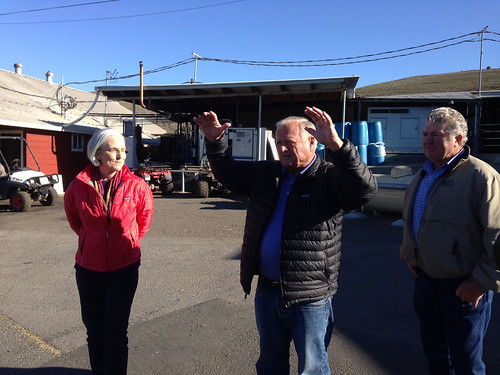
On a recent trip to California, I had the pleasure meeting several farm families who are impacted by the state's worsening drought. Both stops gave me a first-hand view of the challenges these farmers face. We discussed how USDA can further help them with available resources. While the discussion centered on concerns over water supply, I was heartened to see that the Natural Resources Conservation Service’s (NRCS) recommended conservation practices have helped them better prepare for the state’s historic water shortage.
During the first stop, I visited with a distinguished dairyman and conservationist in Marin County, Bob Giacomini, and his four daughters, who operate the Point Reyes Farmstead Cheese Company. Driving over the hill towards Bob’s milking complex, I could see the pastures had little, if any, grass. In talking to Bob, he said that typically the grass would be at least two feet tall by now. He has real concerns about having enough forage for his cows. I also spoke with Paul Bianchi, who had joined us. Paul owns a dairy operation in neighboring Sonoma County and, like Bob, is very concerned about his ability to feed his cows. Both discussed the real possibility that they may have to sell some of their herd.
Bob and his daughters have diversified their operation, turning a sustainable dairy farm into an artisan cheese company as well. They have worked with NRCS to adopt conservation practices to protect water quantity, manage their manure and work toward operating the dairy "off the grid." Recently, they installed an anaerobic digester that converts methane from manure decomposition into an alternative energy source that powers nearly all of the dairy. The practice not only helps them protect the nearby lagoon, but also the Point Reyes National Seashore. And it produces fertilizer they can spread on their pastures or sell to local nurseries. The Giacomini’s operation stands as a model for sustainable conservation in the dairy industry.
Next, I visited Giovannoni Vineyards, in nearby Napa County, run by Dave Troppy. This small family vineyard operates about 40 acres, producing high-quality grapes for Napa vintners. With the help of NRCS, the family installed a suite of conservation practices to conserve water. Dave walked me to the vineyard's reservoir, which normally this time of year is about 20 feet deep. That day we could have walked across it. He told me he had just enough water for one more round of irrigation.
Dave and his family are constantly looking for ways to maximize their available water. They have worked with NRCS to use water management techniques to assess the appropriate amount of water to apply in the correct intervals, and the use of a permanent cover crop and mulch to increase the soil's health and water holding capacity. They also continually visit with the local Farm Bureau, wine grape growers association and others to find ways to work together to get through this dry period. Together, they have considered a number of innovative approaches, including creating a community composting site.
Each of these farmers was clear-eyed about the challenge ahead. They recognize that droughts are part of California’s history and will be part of their future. While they are very concerned about the effect of the state’s most severe drought on record, they haven’t given up hope and are eager to invest in conservation practices that will allow them to mitigate the effects of this and future droughts. What I saw in California underscores the importance of having the full array of tools and programs so that USDA can help meet the needs of farmers in California and across the country. It underscores the importance of the federal government working collaboratively under President Obama’s new National Drought Resilience Partnership to help states and rural communities build their resilience now and in the future.
